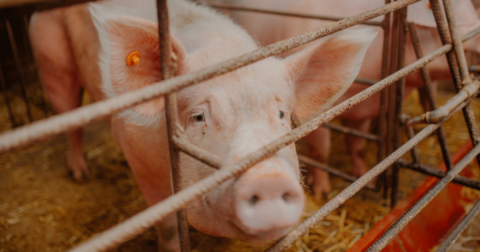Perspective
How Meat Became Cool Again in 2025
Diet•4 min read
Reported
The meat industry’s routine use of antimicrobials is making humans more vulnerable to disease and death.


Words by Sophie Kevany
It’s a well-known fact that factory farms rely on antibiotics to treat animals raised in cramped, unsanitary conditions. Lesser known is the rising quantity of antibiotics needed to do just that. Sales of medically important antibiotics for use in U.S. livestock farming rose over four percent in 2022, compared to a year earlier, and show an overall upward trend since 2018, risking greater human mortality from antibiotic-resistant infections.
Medically important antimicrobials — a broader term for drugs, including antibiotics, that kill microorganisms — are those considered essential for treating human disease. Globally, the livestock industry fed an estimated 99,502 metric tons of antimicrobials in 2020 to the billions of cattle, sheep, chicken and pigs raised for food that year.
Such widespread antimicrobial use has been linked to the development of resistant bacteria and other organisms like fungi. Infection from antimicrobial-resistant organisms is described as a “growing crisis” by the American Public Health Association and other health professionals and scientists.
People and animals infected by resistant organisms are harder to cure. In the U.S., the Centers for Disease Control estimates there are over 2.8 million antibiotic-resistant infections every year. Of those, over 35,000 people eventually die. Globally, one study found there were an estimated 4.95 million deaths associated with bacterial antimicrobial resistance.
The Food and Drug Administration data show sales of medically important antimicrobials approved for use in farm animals rose 4.3 percent to 6.25 million kilograms in 2022. The 2022 figure is a significant decrease on the 8.36 million kilograms sold in 2016, the earliest year shown in the data. But the 2022 figure is higher than all other years since 2016, indicating a more recent trend in the wrong direction.
Thomas van Boeckel, an expert in global antimicrobial usage and resistance in farm animals, fish and humans, says the upward swing indicates that “unlike some European and Asian countries … the U.S. is clearly not on a trend that shows its commitment to sustainably reduce antimicrobial use in animals.”
The data, he adds, shows the problem is “mostly a pig and cattle issue” and reveals “a dependence” by the livestock sector on antibiotics that has “potential consequences on the continued development of resistance.”
Prior to 2016, the use of medically important drugs for livestock was even higher, says Steven Roach of the Food Animal Concerns Trust. To control the problem, federal rules were tightened in 2017 to prevent farmers using the drugs for growth promotion.
By species, the administration’s data shows 2022 sales of medically important antibiotics for cattle were up 4.3 percent to 2.57 million kilograms, higher than any other year since 2016. For pigs, sales rose almost 5 percent to 2.66 million kilograms, again higher than any year since 2016.
Farmers use antimicrobials in three ways, Roach says. “Treating a sick animal, which everyone supports. Treating a particular group of animals, for example if there is a risk of infection from one sick animal, which we also support,” he says.
The third use, which Roach opposes and is prohibited in Europe, is treating healthy animals to prevent disease, a practice known as prophylaxis. For example, Roach says, months of preventative treatment of cattle can happen in feedlots where the animal’s weight promoting, high energy diet produces a bacteria that can infect their livers. To prevent liver problems, medically important antimicrobials called macrolides are used, Roach says.
Most antimicrobials are fed to livestock via their feed and water. Research has linked the addition of antimicrobials to water with the faster breeding and spread of resistant bacteria between animals and feedlot workers.
The FDA data, Roach added, does not “tell us the percentages of how much of each antimicrobial is used for which category,” making it hard to know the level of preventative use.
Not only does Roach agree that the U.S. livestock sector is falling behind other countries in using more, not less, medically important antimicrobials, he says the government appears uninterested in the problem.
“We can’t even get anyone in the U.S. government to say that there is a need to reduce medically important antimicrobials in food animals,” he says, blaming livestock industry lobbying for the current predicament.
Roach hopes the FDA “will realize it has to act and follow the EU and prohibit the use of [the drugs] for disease prevention.” He adds, “the FDA could also set a public health goal to reduce their use, say by 50 percent by a certain year, which is what other countries have done.”
Absent government action to prevent prophylactic use of the drugs, Roach says the most successful route to reducing their use in livestock is consumer pressure. “We have had good luck getting big meat buyers to put pressure on companies. The good news is in chicken, it is going down and part of that was pressure on the companies [to reduce their use of medically important antimicrobials] and a choice by Tyson and Perdue to quit using them.”
Some companies are avoiding antibiotics altogether. “[Our] family farmers and ranchers prove every day that routine antibiotic use is not necessary when animals are provided a low-stress environment with extra space, fresh air and humane animal care,” says Chris Oliviero, who leads the Niman Ranch network of independent meat producers. Niman Ranch animals that must be treated with antibiotics are not sold as meat.
Neither the National Cattlemen’s Beef Association nor the National Pork Producers Council replied to Sentient Media’s requests for comment.
Answering the criticisms raised here, the Food and Drug Administration said in an email that it is “committed to the judicious use of antimicrobials in food-producing animals” and that it continues to take “many actions to promote judicious use, reduce inappropriate use …. [and] try to curb the development of antimicrobial resistance (AMR) that could stem from antimicrobial use in food-producing animals.”
Those actions, it said, include rules that now ensure “all medically important antimicrobials for food-producing animals are only available under the supervision of a licensed veterinarian.”
Asked about policies to restrict antibiotic use on factory farms elsewhere in the world, the email said U.S. laws and livestock population “are not the same as that of the EU or other countries. The FDA’s initiatives to promote judicious use and reduce AMR were devised specifically for the U.S.”
It added that there are “many factors to consider” when analyzing antimicrobial sales data. These include sales volume fluctuations “in response to various factors, including changing animal health needs or changes in animal populations that may make certain antimicrobial drugs more medically important at various times.”
The American Veterinary Medical Health Association also replied, arguing that antimicrobial sales data is “a valuable indicator of market trends” but that it “does not necessarily reflect the actual use of antimicrobial drugs.” Pointing to more detailed biomass data, which includes animal weights, the association further suggested that higher animal numbers might be a factor saying that “… overall, animal populations have been growing annually since 2016 … [which would] impact the amount of antimicrobials sold and could be one factor contributing to an increase in antimicrobial sales.”
Yet according to FACT’s Steven Roach, a closer look at the data suggests sales may be even higher. “If you look at the more detailed biomass data referred to by the AVMA it shows that animal numbers were down in 2022 compared to 2021 so when corrected for biomass the [medically important anti-microbial] sales increases are even larger.”